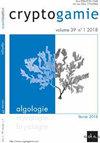从皮质光养生物膜中分离的一种Phyllosiphon duini sp. 11 . (Trebouxiophyceae,绿藻门)
IF 1.5
4区 生物学
Q3 MARINE & FRESHWATER BIOLOGY
引用次数: 7
摘要
Trebouxiophyceae的Watanabea分支包括单细胞球藻绿色微藻,主要生长在陆地微生境中。近年来,在DNA序列数据和形态学观察的基础上,发现了许多新的属和种。奇特的Phyllosiphon属,在Watanabea分支中形成一个单系分支,其特点是在天南星科的叶子中形成虹吸寄生阶段。此外,先前的一些研究表明,Phyllosiphon属的成员还包括自由生活的小球藻个体,它们出现在各种陆上基质上。从欧洲陆地微生境取样的许多Phyllosiphon成员到目前为止还没有被分类描述,因为它们没有在培养物中可用。本文对生长在亚地中海森林林分的短毛栎(Quercus pubescens)上的皮状生物膜中分离到的叶根虹吸属(Phyllosiphon)一新种P. duini进行了分类描述。该菌株的简单球粒形态并不能明确地将叶虹吸管与其他密切相关的Watanabea分支成员区分开来。然而,基于18S rDNA序列的系统发育分析表明,该物种与先前在东亚描述的一种Phyllosiphon聚集在一个姐妹位置。Watanabea分支成员的rbcL基因序列也支持类似的系统发育模式。我们的数据表明,Phyllosiphon属代表了Watanabea分支的水下绿球藻绿色微藻的不同系统发育谱系。本文章由计算机程序翻译,如有差异,请以英文原文为准。
Phyllosiphon duini sp. nov. (Trebouxiophyceae, Chlorophyta), a Species Isolated from a Corticolous Phototrophic Biofilm
Abstract The Watanabea clade of the Trebouxiophyceae includes unicellular coccoid green microalgae that mostly thrive in subaerial microhabitats. Recently, a number of new genera and species were described on the basis of the DNA sequence data and morphological observations. The peculiar genus Phyllosiphon, which forms a monophyletic clade within the Watanabea clade, is characterized by forming siphonous parasitic stages thriving in the leaves of the Araceae. In addition, several previous studies demonstrated that members of the genus Phyllosiphon also include free-living chlorelloid individuals that occur on various subaerial substrates. A number of Phyllosiphon members sampled from European subaerial microhabitats have so far not been taxonomically described, because they were not available in cultures. In this study, we provide a taxonomic description of a new species of the genus Phyllosiphon, P. duini, isolated from a corticolous biofilm growing on Quercus pubescens in a sub-Mediterranean forest stand. The simple chlorelloid morphology of this strain did not unambiguously distinguish Phyllosiphon duini from other closely related members of the Watanabea clade. However, phylogenetic analyses based on the 18S rDNA sequences showed that this species clustered in a sister position to a Phyllosiphon species previously described from eastern Asia. Similar phylogenetic pattern was also supported by the plastid-encoded rbcL gene sequences of members of the Watanabea clade. Our data demonstrate that the genus Phyllosiphon represents a diverse phylogenetic lineage within the subaerial chlorelloid green microalgae of the Watanabea clade.
求助全文
通过发布文献求助,成功后即可免费获取论文全文。
去求助
来源期刊

Cryptogamie Algologie
生物-海洋与淡水生物学
CiteScore
2.60
自引率
7.70%
发文量
11
审稿时长
>12 weeks
期刊介绍:
Cryptogamie is a fast-track and peer-reviewed journal of international scope publishing in English only. It accepts original papers and review articles on the taxonomy, biology and ecology of all cryptogams. An issue of Cryptogamie may be devoted to a single topic, under the responsibility of guest editor(s). All articles published in Cryptogamie are compliant with the different nomenclatural codes. A copyright assignment will be signed by the authors before publication.
Cryptogamie, Algologie accepts articles on systematics as well as ecology and evolution of any kind of algae (including Cyanobacteria).
 求助内容:
求助内容: 应助结果提醒方式:
应助结果提醒方式:


